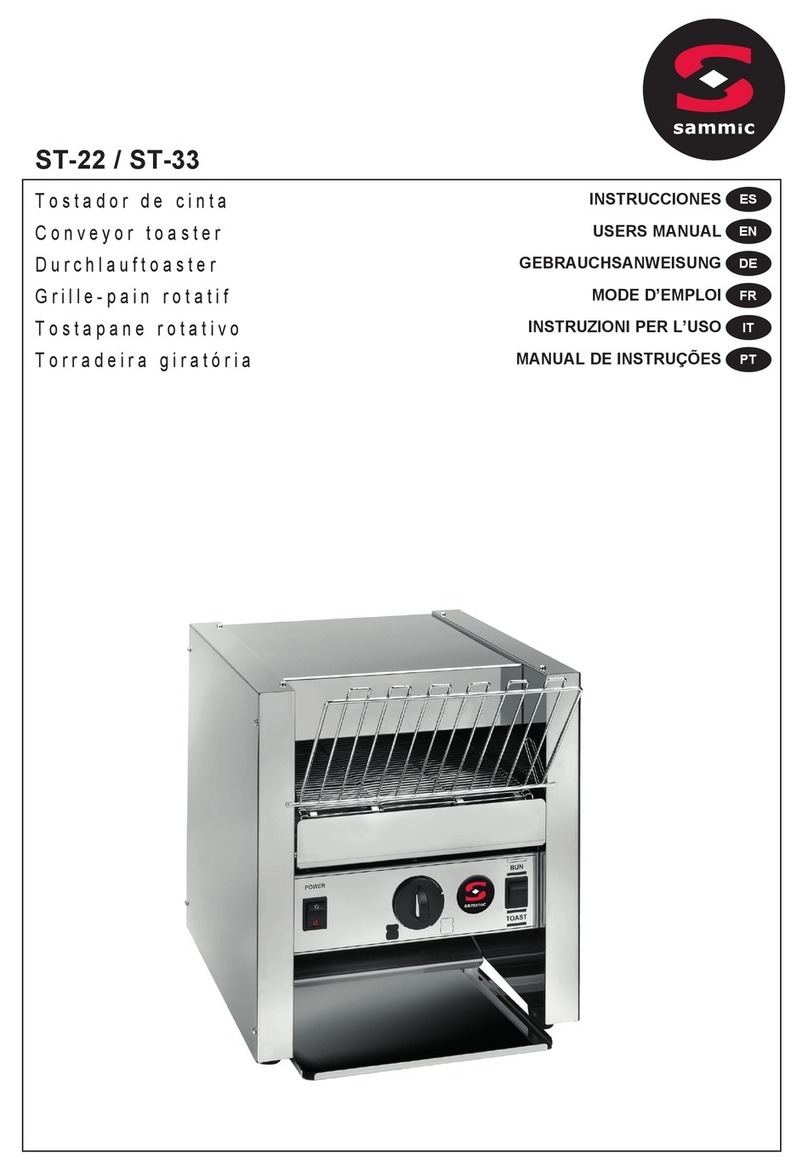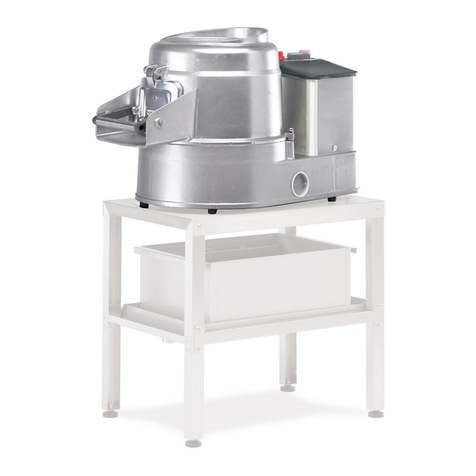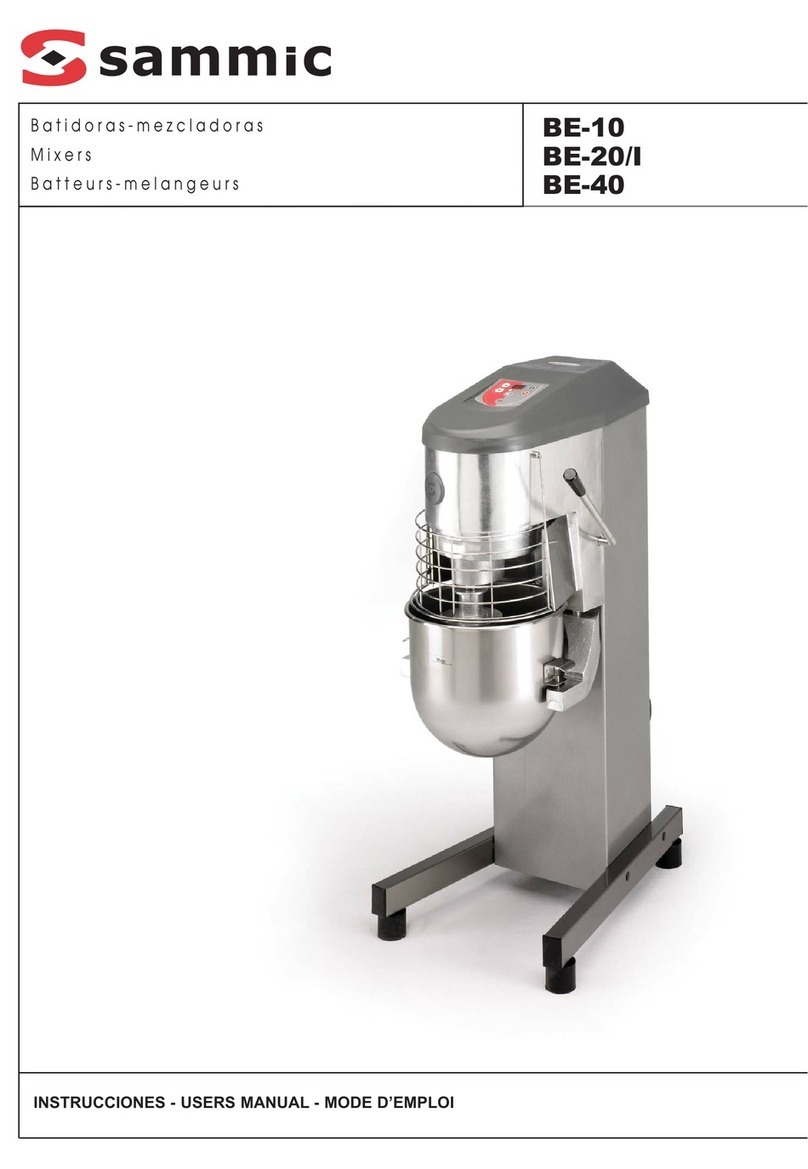
8
- 8 -
ES
Función FORCE CONTROL:
Cuando el motor esta en marcha mediante el aro 3 de la pantalla se repre-
senta el nivel de fuerza que esta haciendo el motor. Cuando se el nivel se
acerca a las posiciones rojas indica que el motor va forzado. Este nivel varia
según las características del producto que se esta procesando.
LIMPIEZA
Limpieza de accesorio “Cortadora Hortalizas” CK-35V/38V, CK-
45V/48V y CA-3V/4V:
- Desbloquear el cierre (I) y abrir la tapa articulada(J).
- En la CK-45V/48V y CA-4V, sujetando el disco (A) con la mano sin tocar
las cuchillas, utilizar la llave (P) suministrada junto con la máquina para
desmontar la broca (Q) o el revolvedor (R), desenroscándolo en sentido
antihorario.
- Retirar el disco (A) girándolo en sentido horario y tirando de él hacia arriba
cuidadosamente. Retirar la rejilla (B) y el expulsor (C).
- En la CK-35V/38V y CA-3V es posible desmontar el pisador (M) y la tapa
articulada (J) para facilitar su limpieza. Para ello hay que desmontar los
pasadores (N y O).
ATENCION: Para poder retirar los productos encajados en las rejillas
(B) basta con golpearlas con una patata alargada o una zanahoria
entera en el sentido de corte. De esta forma no se daña la rejilla (B).
Tener precaución con el lo de la rejilla (B). Nunca utilizar objetos
duros para golpear la rejilla(B).
También existe en el catalogo de Sammic un limpiador de rejillas para las
rejillas FMC-8D y FMC-10D.
Los discos ralladores SH están diseñados de tal forma que la chapa se
puede separar del armazón para su limpieza.
Limpieza de accesorio “Cutter” (CK-35V/38V, CK- 45V/48V y KE-5V/8V):
- Si la suciedad esta seca, adherida a la olla y a las cuchillas, poner agua
caliente y detergente en la olla y hacer funcionar a la máquina para que los
residuos se ablanden.
- Para evitar salpicaduras, una vez procesado el producto, quitar la tapa (U),
colocar la seguridad de la bayoneta (Y) en posición abierta (AA) y quitar la
olla (S) con la cuchilla dentro(T).
- Es posible desmontar el revolvedor (V+X) de la tapa (U). Para ello, man-
Una vez realizadas estas operaciones se puede separar el revolvedor y la
manivela revolvedor. Para montar de nuevo el revolvedor, introducir de nuevo
el revolvedor (X) en la tapa (U) y la manivela revolvedor (V) en el revolvedor
(X). Empujar el revolvedor (X) y la manivela revolvedor (V) contra la tapa
y girar la manivela revolvedor (X) hasta llegar al tope. Una vez ejecutadas
estas acciones separar el revolvedor (X) y la manivela revolvedor (V).
Limpieza del bloque motor CK:
El exterior de la máquina NO SE DEBE limpiar con un chorro directo de
agua. Emplear para su limpieza un paño húmedo y cualquier detergente
habitual. NO SE DEBEN utilizar detergentes abrasivos (agua fuerte, lejía
concentrada etc…) ni estropajos o rasquetas que contengan acero común,
pueden causar la oxidación de la máquina.
Accesorio “Cortadora Hortalizas”: Funcionamiento de discos (A) y
rejillas (B).
- Discos (A):
1 y 2mm.
- Discos (A) de FC-3D a FC-25+ para obtener rodajas de 3 a 25mm de
patatas, zanahorias, remolachas, coles, pepinos, calabacines, cebollas,
rábanos, etc.
- Discos (A) con cuchilla curva, para productos blandos, FCC-2+, FCC-3+ y
FCC-5+ para cortar en rodajas toma1te, naranja, limón, plátano, manzana,
etc.
- Discos (A) ralladores tipo SH, desde 2 a 7mm, para deshilar verduras y
rallar queso, pan, nueces, almendras, etc.
Para cortar patatas del tipo “paja” y “cerilla”, tiras de zanahorias, apio, remo-
lacha, etc., discos (A) FCE-2+ , FCE-4+ y FCE-8+
- Discos (A) SH-1 y SH-8 para rallar el pan, queso, chocolate, etc.
- Discos (A) y rejillas (B). Combinaciones posibles:
- Los discos(A) FC-6D, FC-8D, FC-10D combinadas con las rejillas(B), FFC-
8+ y FFC-10+ se obtienen patatas del tipo “fritas”.
- Los discos (A) FC-3D, FC-6D, FC-8D, FC-10D y FC-
14D combinados con las rejillas (B) FMC-8D, FMC- 10D y FMC-14D, se
obtienen dados y/o cubos de 3 a 14 mm de patatas para tortillas, de hortal-
izas y frutas para macedonia, ensalada rusa, etc.
- Los discos (A) FC-20+ y FC-25+ combinados con las rejillas (B) FMC-20+
y FMC-25+ se obtienen dados y/o cubos de 20x20 y 25x25.
- Existe en el catalogo de Sammic un limpiador de rejillas para las rejillas
FMC-8D y FMC-10D.
Broca (Q) y Revolvedor (R). CK-45V/48V y CA-4V.
- Broca (Q): Es utilizada exclusivamente para trabajos en col o similares.
Gracias a ella es posible cortar piezas enteras.
- Eje revolvedor(R): Hay que utilizarlo con todos los productos menos la col
y similares.
Expulsor alto y normal (C).
el apio y para el rallado de productos como queso, zanahorias...
- Expulsor normal: Resto de cortes.
Accesorio “Cutter”.
Mediante el accesorio “Cutter” se puede:
PICAR: Perejil, ajo, cebolla, queso, jamón coci- do, carne cocinada, etc...
SALSAS: Tomate, mayonesa, tártara, alioli, verde, gazpacho, etc...
PURES: Legumbres, verduras, compotas, etc... PASTAS: Gambas, mejil-
lones, ostras, carne, embutidos, etc...
SOPAS / CREMAS: Marisco, ajo, verduras, legumbres, carne, etc...
En repostería:
PICAR: Almendras, avellanas, chocolate, pasas, frutas para macedonia, etc...
PREPARAR: Azúcar glass, pasta de almendras, batir nata; crema de
chocolate, vainilla, café, fresas y frutas en general, etc...
AFILADO DE CUCHILLAS
ATENCION: Los discos (A), rejillas (B) y el conjunto cuchillas (T) están
provistos de cuchillas muy aladas, por tanto hay que manipularlas
cuidadosamente.































